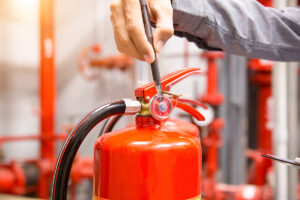
A fire protection system inspection ensures that your systems are operational and in optimal condition.
Fire protection systems are critical to the safety and security of any commercial building. These systems—such as fire sprinklers, alarms, and suppression equipment—are designed to save lives, minimize property damage, and ensure the safety of occupants. However, to function effectively, these systems must be regularly inspected and maintained. An inspection ensures that everything is in working order and meets the necessary regulatory requirements. Preparing for a fire protection system inspection can ensure that your facility is on top of fire safety protocols and help the inspection process go more smoothly.
Know What Systems Will Be Inspected
Before your inspection, it’s essential to know which components of your fire protection system will be reviewed. Fire protection inspections generally focus on the following systems:
- Fire Alarms: These include smoke detectors, pull stations, and notification systems like horns and strobes.
- Sprinkler Systems: Inspectors will review sprinkler heads, water pressure, pipes, and control valves to ensure they function correctly.
- Fire Extinguishers: Extinguishers must be easily accessible, fully charged, and inspected annually by a licensed professional.
- Fire Suppression Systems: These include specialized systems in areas like commercial kitchens, where grease fires can occur. They are typically foam or chemical-based suppression systems.
- Emergency Lighting and Exit Signs: Inspectors will ensure that emergency lighting works and that exit signs are clearly visible and illuminated.
- Standpipes and Hydrants: For larger buildings, standpipes and fire hydrants must be properly maintained to ensure they are ready for fire department use.
Review Your Inspection History
One key step to preparing for an inspection is to review your fire protection system’s inspection history. Ensure that any deficiencies noted in prior inspections have been addressed. If corrective actions were taken, have documentation ready to show the inspector.
Regularly scheduled maintenance of your systems will ensure that they are in working order and prevent last-minute scrambling. Keeping up with scheduled tests, such as the monthly testing of fire alarms or the annual inspection of fire extinguishers, can make your overall inspection much smoother.
Conduct a Pre-Inspection Walkthrough
A few weeks before the scheduled inspection, conduct your own walkthrough. Check for any obvious issues that may need attention:
- Blocked Sprinkler Heads: Make sure that nothing is obstructing your sprinkler heads. Even items like decorations or furniture placed too close can hinder their effectiveness.
- Clear Exits: Ensure that all emergency exits are free of obstructions. Fire exits must be accessible at all times, and the doors should function correctly.
- Access to Control Valves: Sprinkler control valves must be accessible and in the correct position. If valves are closed or tampered with, your system won’t function properly.
- Fire Alarm Testing: Ensure that fire alarms are functioning correctly by conducting a test. You should check batteries in smoke detectors, ensuring they are fully operational.
By identifying and addressing any minor issues, you can save yourself from costly delays or a failed inspection.
Ensure Proper Documentation is Available
Fire protection system inspections often require detailed records of prior inspections, maintenance, and system testing. Ensure that your documentation is up to date and accessible on the day of the inspection. This should include:
- Records of past inspections
- Testing and maintenance logs
- Fire alarm system performance reports
- Fire extinguisher servicing reports
Having your paperwork organized and available will help expedite the process and demonstrate your commitment to fire safety compliance.
Communicate with Your Fire Protection Service Provider
In many cases, fire protection system inspections are conducted by a certified fire protection service provider. Before the inspection, confirm the date and time with your provider and ask if there’s anything specific you need to do in preparation. They may offer suggestions or checklists to ensure that you are fully prepared.
Inform Building Occupants
If the fire protection system inspection involves testing fire alarms or other disruptive activities, inform your building’s occupants in advance. Providing notice allows everyone to prepare for potential noise, water shutoffs, or brief evacuations during alarm testing.
For businesses, this communication is crucial for avoiding confusion, as occupants may mistake tests for actual emergencies. Clear, concise communication will ensure that everything runs smoothly and without panic.
Fire Protection Services from Fireline
Whether you need smoke detectors, fire extinguishers, or an automatic sprinkler system installed at your commercial property, Fireline has you covered. We have been protecting people and property from fire damage since 1947—and our experience shows in our excellent work! We are known for our superb customer service, our expertise, and our reliability. For more information on how we can help your residential or commercial property, visit us online or give us a call at (800) 553-3405. We are in Baltimore, MD, with a second office in Leesburg, VA. For more fire safety tips, be sure to follow us on Facebook, Twitter, and LinkedIn.
